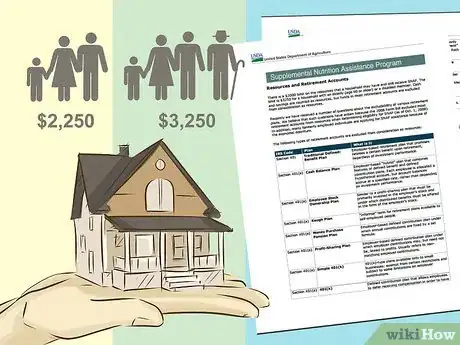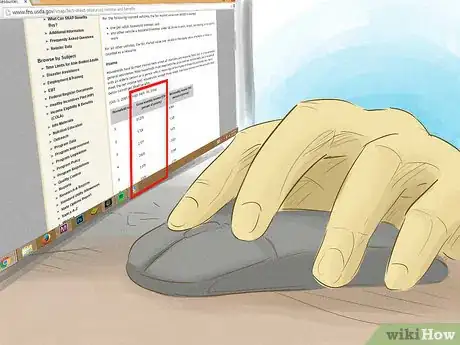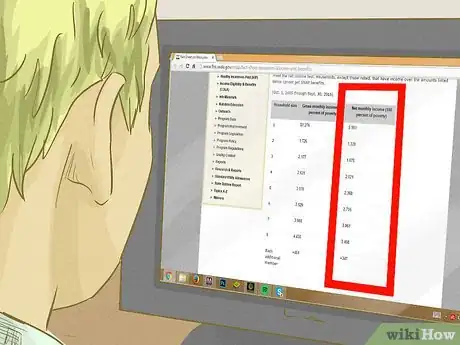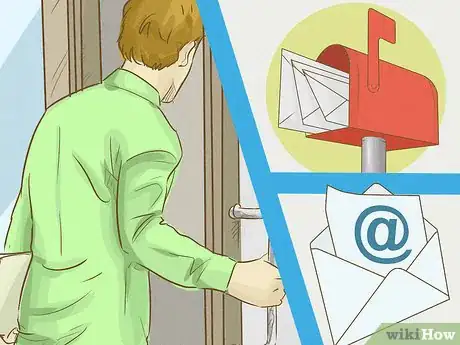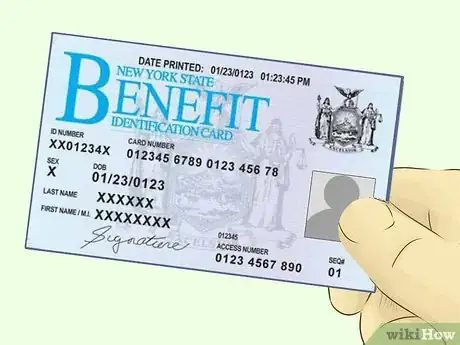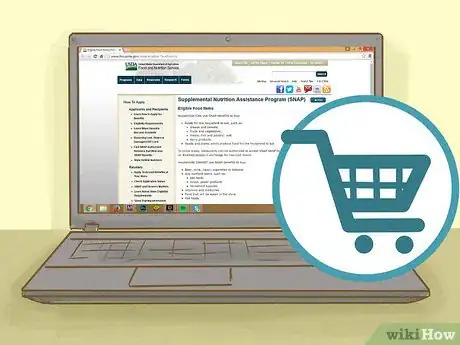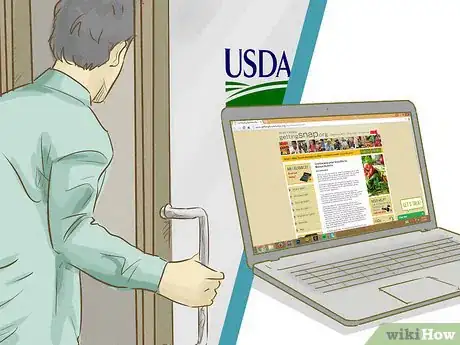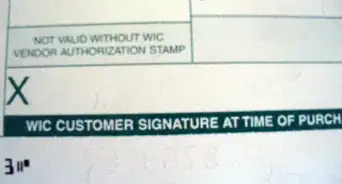wikiHow is a “wiki,” similar to Wikipedia, which means that many of our articles are co-written by multiple authors. To create this article, 10 people, some anonymous, worked to edit and improve it over time.
There are 9 references cited in this article, which can be found at the bottom of the page.
This article has been viewed 635,590 times.
Learn more...
The United States Department of Agriculture Food and Nutrition Services funds the food stamp program in all fifty states. Officially, the food stamp program is the known as the Supplemental Nutrition Assistance Program (SNAP). The allotment of SNAP benefits depends on household size and income. With this information available, you can estimate the amount in benefits you will receive.
Steps
Determining How Much Assistance You Qualify For
-
1Determine your resources on hand. Households may have $2,250 in countable resources, such as a bank account, or $3,250 in countable resources if at least one person is age 60 or older, or is disabled.[1] Select states may also consider the worth of a vehicle as a countable resource.[2] Check with your local SNAP office for details regarding your state.
- Select retirement plans may also count as a resource.
- Resources that are not countable include a home and lot, the resources of people who receive Supplemental Security Income (SSI), the resources of people who receive Temporary Assistance for Needy Families (TANF), and excluded retirement or pension plans.[3]
-
2Determine your gross income. Gross income is your household's monthly total income from all sources before removing allowable deductions (deductions discussed below). Total income includes money made from work, money paid from disability payments, and money received from child support.Advertisement
-
3Compare your gross income to the qualification limits. Your household must not be above the gross income limits to qualify for the benefits. The gross monthly income limits depend on the size of the household, and the limits are calculated based on the federal poverty guidelines. As of 2015, the gross monthly income limits are:
- 1 member household: $1,265
- 2 member household: $1,705
- 3 member household: $2,144
- 4 member household: $2,584
- 5 member household: $3,024
- 6 member household: $3,464
- 7 member household: $3,904
- 8 member household: $4,344
- For more than 8 household members, add an additional $440 per extra member
- The above figures are good only for 2015. If you are trying to figure out gross income limits after 2015, visit the USDA website.
-
4Subtract allowable deductions from your gross income. To qualify for benefits, your household must also be at or below the net income limit, which is the gross amount minus allowable deductions. Like with the gross amount, the net amount depends on the household’s net income based on the poverty line for the household size. The allowable deductions and their amounts include:
- All households can deduct 20% of earned income. Additionally, you can remove the standard deduction of $142 for households with 1 to 3 members and $153 for households with more than 3 members.
- The program allows a dependent care deduction for child care or adult care expenses. For example, monthly daycare costs are deductible for households with children.
- Court ordered child support payments are deductible from the gross income. The only child support payments that the household may deduct are legal child support payments.
- Expenses such as rent and utilities are deductible for amounts that are more than half of the gross income (after subtracting other deductions). The maximum for the expenses deduction is $459.
- Households with an elderly or disabled member can deduct medical expenses that exceed the $35 per month "deductible" for out-of-pocket medical expenses.
-
5Determine your eligibility based on net income after deductions. Once you subtract any allowed deductions from gross income, you will have net income. Households applying for SNAP benefits must meet both the gross as well as net income restrictions. The net income maximums for 2015 are:
- 1 member household: $973
- 2 member household: $1,311
- 3 member household: $1,650
- 4 member household: $1,988
- 5 member household: $2,326
- 6 member household: $2,665
- 7 member household: $3,003
- 8 member household: $3,341
- For households over 8, add $394 per extra member.
-
6Multiply your monthly net income by 30% (0.3) and subtract that total from the maximum food assistance allotment. Households that are eligible to receive SNAP are expected to spend 30% of their net income on food. The maximum allotment you could receive is based upon a net income of 0, and it decreases as you come closer to the maximum income. For example, a household of 3 with a net income of $1,500 must subtract $450 (30 percent of $1,500) from the maximum allotment for their household, which is $511 per month. They then subtract the $450 from the $511 maximum. The household will receive a food stamp allotment of $61 for the month. The maximum allotment for 2015 is:
- 1 member household: $194
- 2 member household: $357
- 3 member household: $511
- 4 member household: $649
- 5 member household: $771
- 6 member household: $925
- 7 member household: $1,022
- 8 member household: $1,169
- For each member over 8, add $146 per month for each extra member
Applying for and Receiving Benefits
-
1Locate your SNAP office. If you are eligible, use the interactive map provided by the Department of Agriculture to locate your local office. Just click on your state on the map.[4]
- Your local Social Security office can also help you if you have or are applying for SSI benefits, such as retirement or disability benefits. They have the forms and can send them to the SNAP office. If you don't have SSI, however, you'll need to go to the SNAP office in person.[5]
-
2Follow the instructions provided by your local SNAP office. Several states allow residents to apply online. Others will allow you to download and print an application, call to have one mailed to you, or pick one up in person. Each state’s application will differ, but the type of information requested will the same. It will include:
- Household financial information, such as money spent on rent, house payments, heating and cooling, other utilities, cash on hand or money in a bank account, and income from work or other sources, such as Social Security, disability, child support, or unemployment benefits.
- Government benefits you get now or have received in the past (for example, Medicaid, Medicare, Social Security, or veteran's benefits).
- Medical information for you and/or the people who reside in your household.
- You can check to see if your state has an online application via the USDA website.[6]
-
3Submit your application. Submit your application through the mail, in person, or online if allowed in your state. If you turn your application in at the office and in person, you may be automatically screened for expedited processing, which can usher you through the process in as little as five days.
- If you have less than $100 in your bank account, you may be eligible for emergency SNAP benefits, which will help you receive benefits within seven days.[7]
- Regardless of how you apply, you should generally receive your benefits within thirty days. You will receive benefits starting from your application date if you are approved. For example, if you applied on March 1st and did not get your benefits until March 25th, you will be credited for March 1-25. If you have not heard from the SNAP office regarding your eligibility within thirty days, contact your local office.[8]
-
4Schedule and attend an interview. At your interview, you will need to provide certain documentation of your financial situation. Required documentation may include:
- Proof of your identity, such as a driver’s license or state or military identification card.
- Proof of address (unless you are homeless) such as an electric, gas, water or phone bill, rent receipt, lease, or mortgage statement.
- The Social Security numbers of everyone for whom you apply. If you do not have a Social Security number, you will need to apply for one.
- Proof of all earned and unearned monthly income before taxes or deductions. You can use pay stubs, employer wage statements, pension information, or a benefits letter from Social Security, unemployment compensation, or the Veterans Administration.
- Name, age, and relationship of all household members.
- Proof of immigration status for all non-citizens who are applying.
- Proof of child support payments you make, such as a support order, separation agreement, or child support payment records.
- Proof of medical expenses, especially if you are age sixty or older or you receive federal disability benefits. You can use documents such as doctor or hospital bills, prescription receipts, receipts for over-the-counter medical expenses (if prescribed by a medical practitioner), and transportation costs to get medical care.
- Proof of childcare expenses if you are working, looking for work, or participating in workforce training.
-
5Obtain your EBT card. If you've met all the requirements and passed the interview, you will receive notification of your imminent benefits. You'll receive a plastic electronic card (an EBT card) through the mail that you can use when shopping. It can take up to thirty days to receive.
- The card system works automatically. As long as you have your card and remain eligible, you should receive benefits.[9]
-
6Follow the rules to retain your SNAP benefits. To retain your benefits, you must follow the specified rules and periodically recertify your benefits. The main rule for SNAP benefits pertains to what you can purchase. If you try to purchase non-approved items, you may be penalized, or your benefits may be taken away in some cases. The USDA website includes information on approved and non-approved items.[10]
-
7Recertify your SNAP benefits. To rectify your benefits, you must report to your local SNAP office. Recertification times can range from once a month to once a year. If you do not recertify your benefits, they will be cancelled, and you will have to reapply.[11]
- Most families who have regularly earned income must recertify once a year. Your caseworker will tell you how often you must recertify based on your specific facts and situation.
- If your situation has changed at all since you last reported, you may have to submit verification documents. For instance, if your income has gone down and you need to receive more benefits, you may need to submit proof of income.
Community Q&A
-
QuestionI am in the process of trying to get on disability, and I can't work. I have no money or assets. I live with a friend. She doesn't make me pay to live here until I can get my disability. Can I get food stamps?
 Community AnswerYes. You can receive benefits while waiting for SSD/SSI approval. Please note that once you are approved, you may have to pay back a portion. Please contact your local office for additional information.
Community AnswerYes. You can receive benefits while waiting for SSD/SSI approval. Please note that once you are approved, you may have to pay back a portion. Please contact your local office for additional information. -
QuestionMy food stamps decreased drastically because I get paid bi-weekly, but some months, I happen to get paid 3 times (happens about once or twice a year). Should I only report 2 stubs when this happens?
 Community AnswerNo, you need to report all earned and unearned income. Caseworkers have access to resources, such as the state's department of labor and employment. If you withhold information about your income, that is fraudulent and they will find out eventually. If you are found responsible for fraud, you will be responsible to repay benefits that you did not qualify for.
Community AnswerNo, you need to report all earned and unearned income. Caseworkers have access to resources, such as the state's department of labor and employment. If you withhold information about your income, that is fraudulent and they will find out eventually. If you are found responsible for fraud, you will be responsible to repay benefits that you did not qualify for. -
QuestionCan student financial aid be counted as income when applying for food stamps?
 Community AnswerIncome is normally counted as earned income. However, occassionally they may include gifts, loans and federal grants from school as income.
Community AnswerIncome is normally counted as earned income. However, occassionally they may include gifts, loans and federal grants from school as income.
References
- ↑ http://www.fns.usda.gov/snap/eligibility#Income
- ↑ http://www.fns.usda.gov/snap/eligibility#Income
- ↑ http://www.fns.usda.gov/snap/eligibility#Income
- ↑ http://www.fns.usda.gov/snap/outreach/map.htm
- ↑ http://www.ssa.gov/pubs/EN-05-10101.pdf
- ↑ https://www.fns.usda.gov/snap/state-directory
- ↑ http://www.nyc.gov/html/hra/html/services/snap_applying.shtml
- ↑ http://www.gettingfoodstamps.org/faqsaboutsnap.html
- ↑ http://www.fns.usda.gov/snap/applicant_recipients/eligibility.htm
About This Article
To calculate the amount of food stamps your family will receive, add up the resources you have on hand, which may include a bank account, vehicle, and some retirement plans. Next, determine your gross income from all sources, and subtract any allowable deductions, such as an earned income credit, child care, and some expenses like rent and utilities. Multiply this by 30% and subtract that total from the maximum food assistance allotment for a household of your size to get an estimate of the food stamps you will receive. Keep reading to learn the federal income limits for gross and net income!
